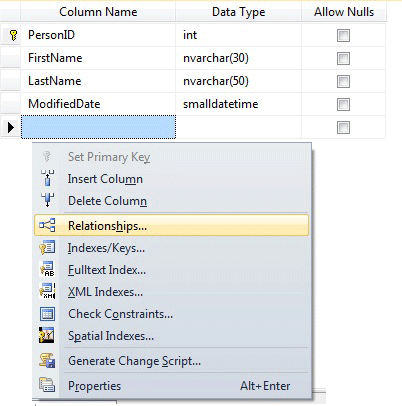Notitie
Voor toegang tot deze pagina is autorisatie vereist. U kunt proberen u aan te melden of de directory te wijzigen.
Voor toegang tot deze pagina is autorisatie vereist. U kunt proberen de mappen te wijzigen.
Van toepassing op: SQL Server 2016 (13.x) en latere versies
Van Azure SQL Database
Azure SQL Managed Instance
Azure Synapse Analytics
Platform System (PDW)
SQL-database in Microsoft Fabric
U kunt een nieuwe tabel maken, deze een naam geven en toevoegen aan een bestaande database met behulp van de tabelontwerper in SQL Server Management Studio (SSMS) of Transact-SQL.
Permissions
Deze taak vereist CREATE TABLE machtiging in de database en ALTER-machtiging voor het schema waarin de tabel wordt gemaakt.
Als er kolommen in de CREATE TABLE-instructie zijn die zijn gedefinieerd als een gebruikersgedefinieerd CLR-type, zijn hetzij eigendom van het type, hetzij referentierechten hiervoor vereist.
Als aan kolommen in de CREATE TABLE-instructie een XML-schemaverzameling is gekoppeld, is het eigendom van de XML-schemaverzameling of de bevoegdheid REFERENTIES hiervoor vereist.
Tabelontwerper gebruiken in SQL Server Management Studio
Maak in SSMS, in Objectverkenner, verbinding met het exemplaar van de database-engine die de database bevat die moet worden gewijzigd.
Vouw in Objectverkennerhet knooppunt Databases uit en vouw vervolgens de database uit die de nieuwe tabel bevat.
Klik in Objectverkenner met de rechtermuisknop op het knooppunt Tabellen van de database en selecteer vervolgens Nieuwe tabel.
Typ kolomnamen, kies gegevenstypen en kies of null-waarden voor elke kolom moeten worden toegestaan, zoals wordt weergegeven in de volgende afbeelding:

Als u meer eigenschappen wilt opgeven voor een kolom, zoals identiteits- of berekende kolomwaarden, selecteert u de kolom en kiest u op het tabblad Kolomeigenschappen de juiste eigenschappen. Zie Tabelkolomeigenschappen (SQL Server Management Studio)voor meer informatie over kolomeigenschappen.
Als u een kolom als primaire sleutel wilt opgeven, klikt u met de rechtermuisknop op de kolom en selecteert u Primaire sleutel instellen. Voor meer informatie, zie Primaire sleutels maken.
Als u relaties met refererende sleutels wilt maken, beperkingen of indexen wilt controleren, klikt u met de rechtermuisknop in het deelvenster Tabelontwerper en selecteert u een object in de lijst, zoals wordt weergegeven in de volgende afbeelding:

Zie Vreemde sleutelrelaties maken, Controlebeperkingen maken en indexen voor meer informatie over deze objecten.
De tabel is standaard opgenomen in het
dboschema. Als u een ander schema voor de tabel wilt opgeven, klikt u met de rechtermuisknop in het deelvenster Tabelontwerper en selecteert u Eigenschappen, zoals wordt weergegeven in de volgende afbeelding. Selecteer in de vervolgkeuzelijst Schema het juiste schema.
Zie Een databaseschema makenvoor meer informatie over schema's.
Kies in het menu BestandOpslaantabelnaam.
Typ in het dialoogvenster Naam kiezen een naam voor de tabel en selecteer OK.
Als u de nieuwe tabel wilt weergeven, vouwt u in Objectverkennerhet knooppunt Tabellen uit en drukt u op F5- om de lijst met objecten te vernieuwen. De nieuwe tabel wordt weergegeven in de lijst met tabellen.
Gebruik Transact-SQL
Maak in Objectverkennerverbinding met een exemplaar van Database Engine.
Selecteer op de standaardbalk Nieuwe query.
Kopieer en plak het volgende voorbeeld in het queryvenster en selecteer uitvoeren.
CREATE TABLE dbo.PurchaseOrderDetail ( PurchaseOrderID INT NOT NULL, LineNumber SMALLINT NOT NULL, ProductID INT NULL, UnitPrice MONEY NULL, OrderQty SMALLINT NULL, ReceivedQty FLOAT NULL, RejectedQty FLOAT NULL, DueDate DATETIME NULL );